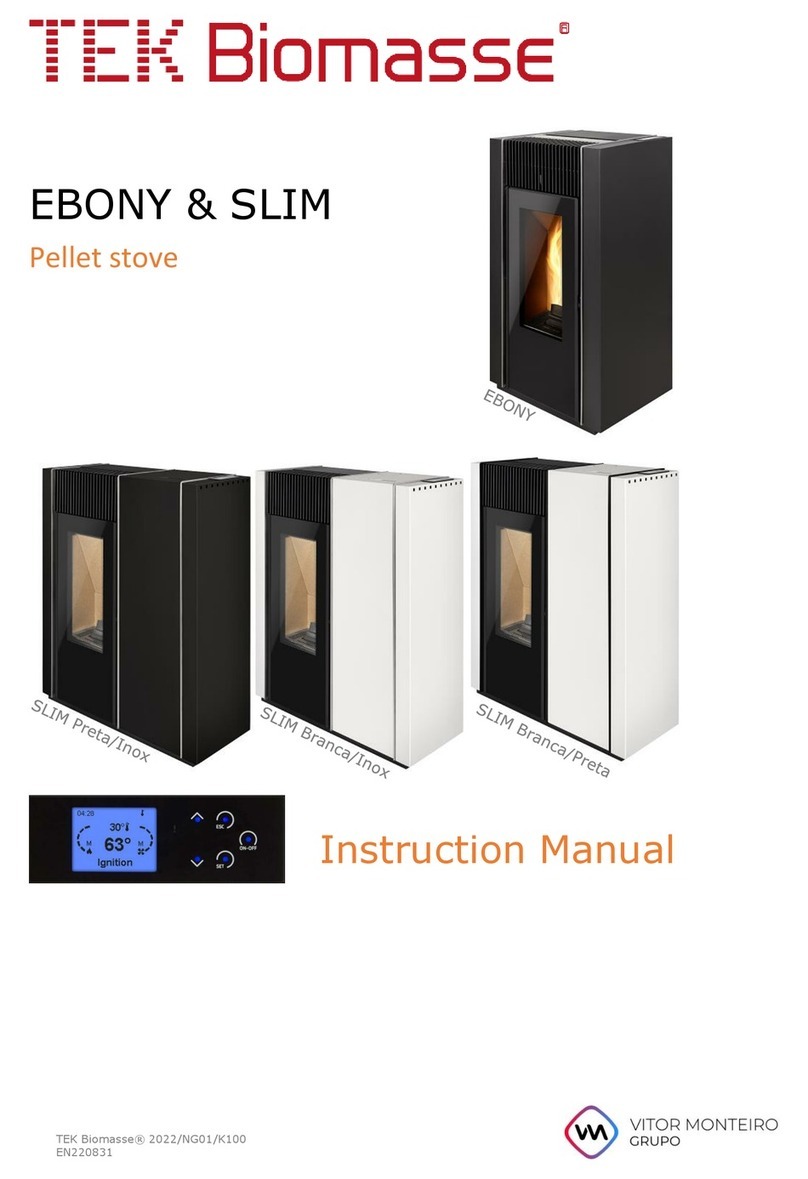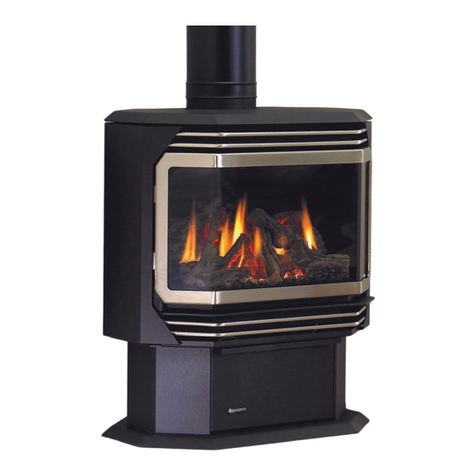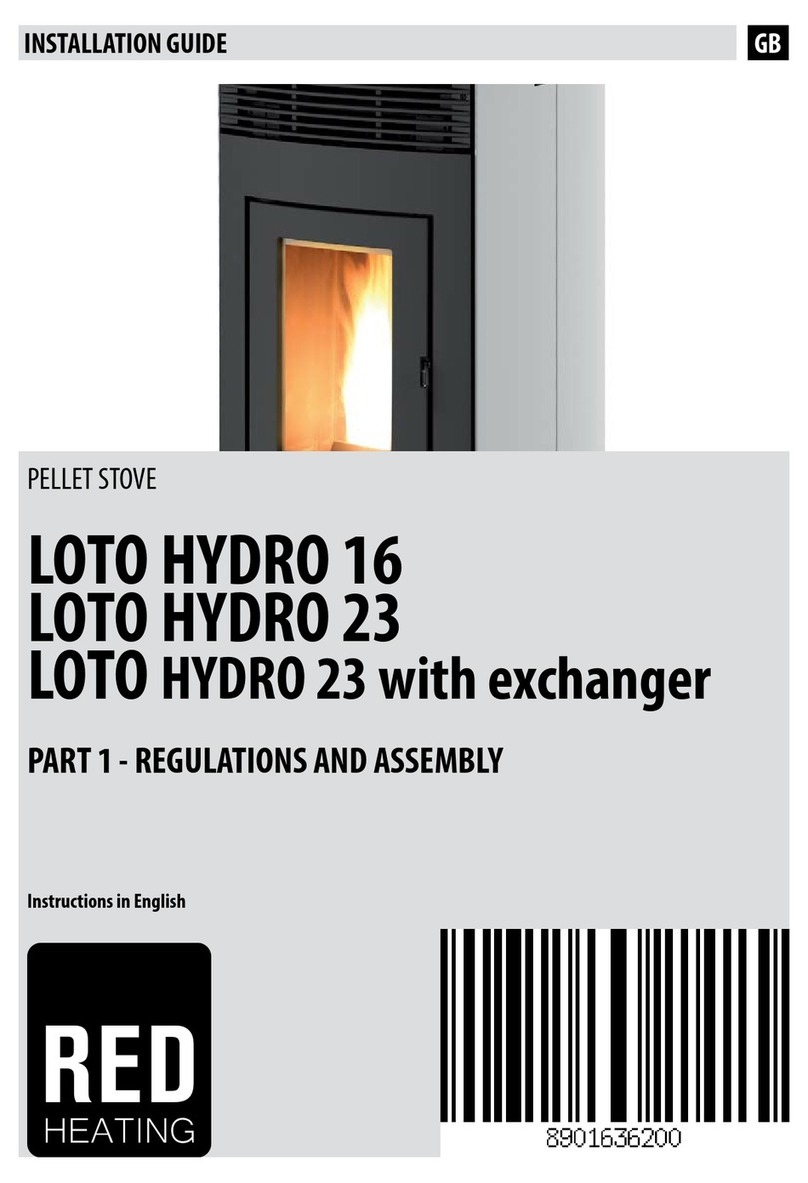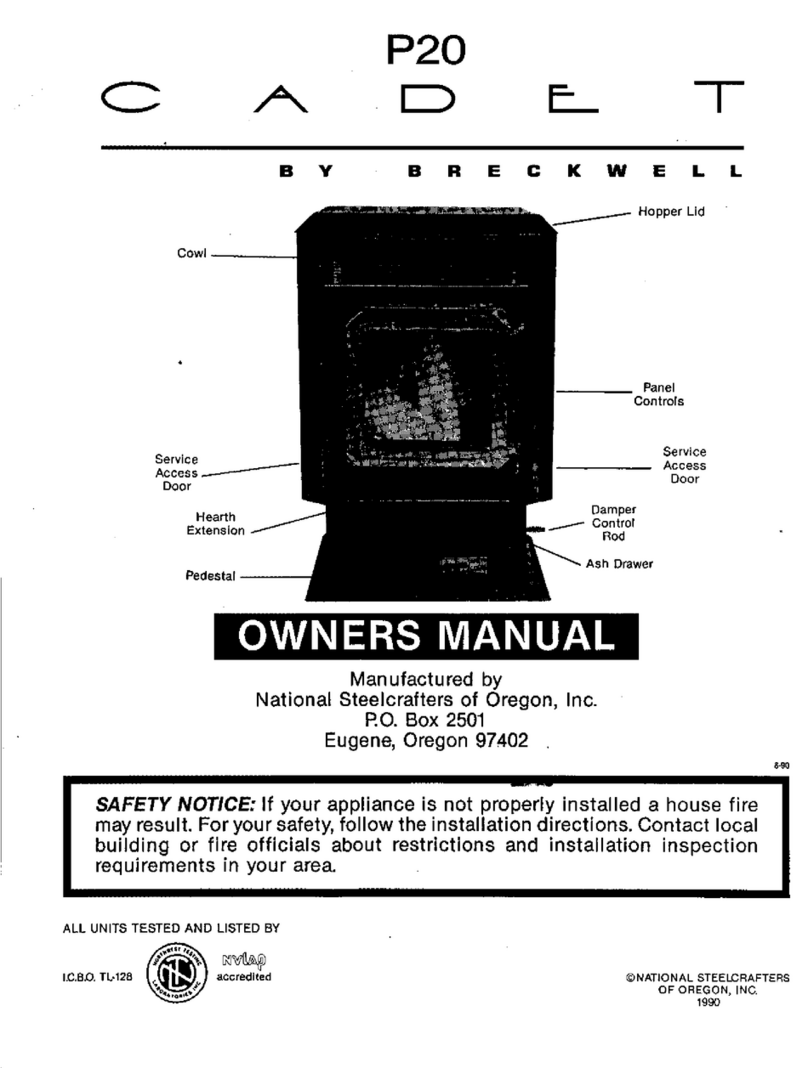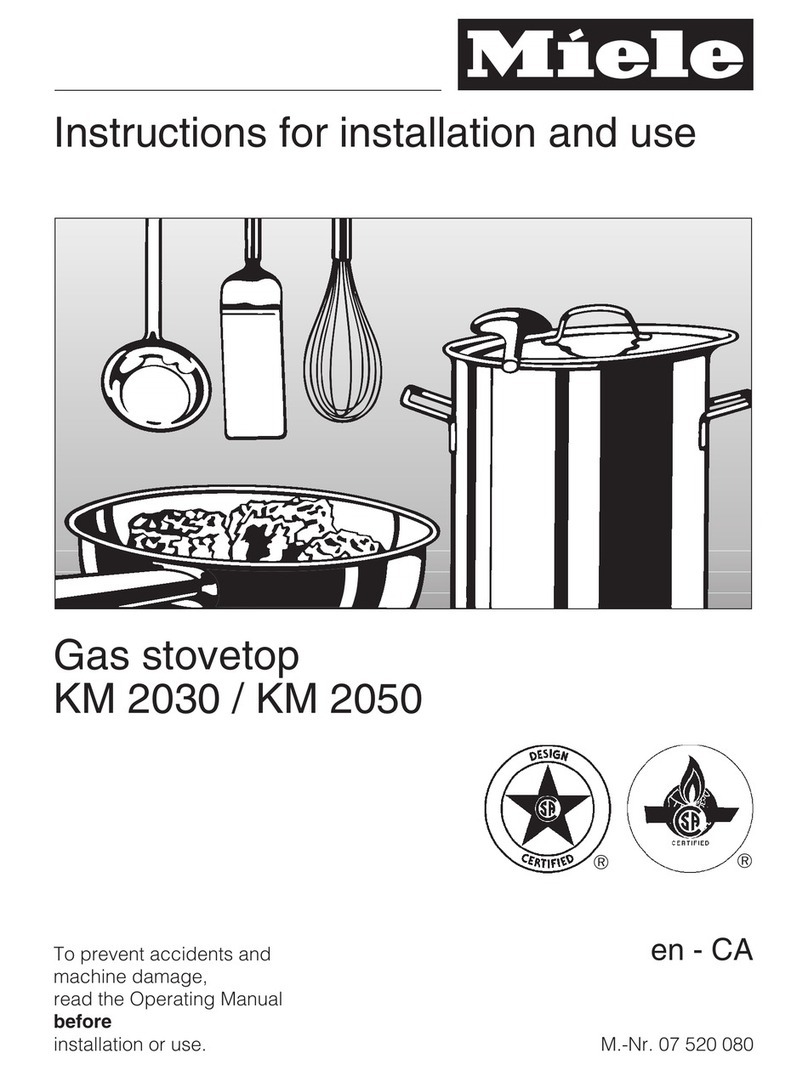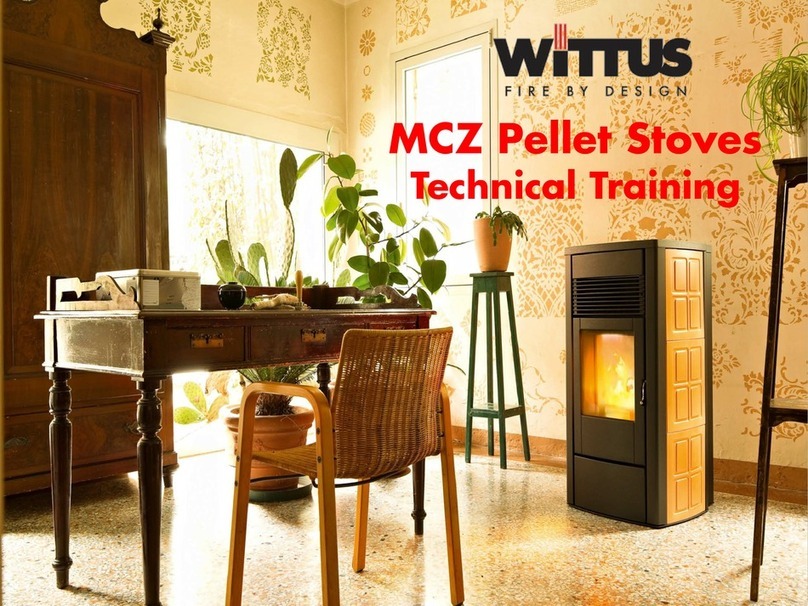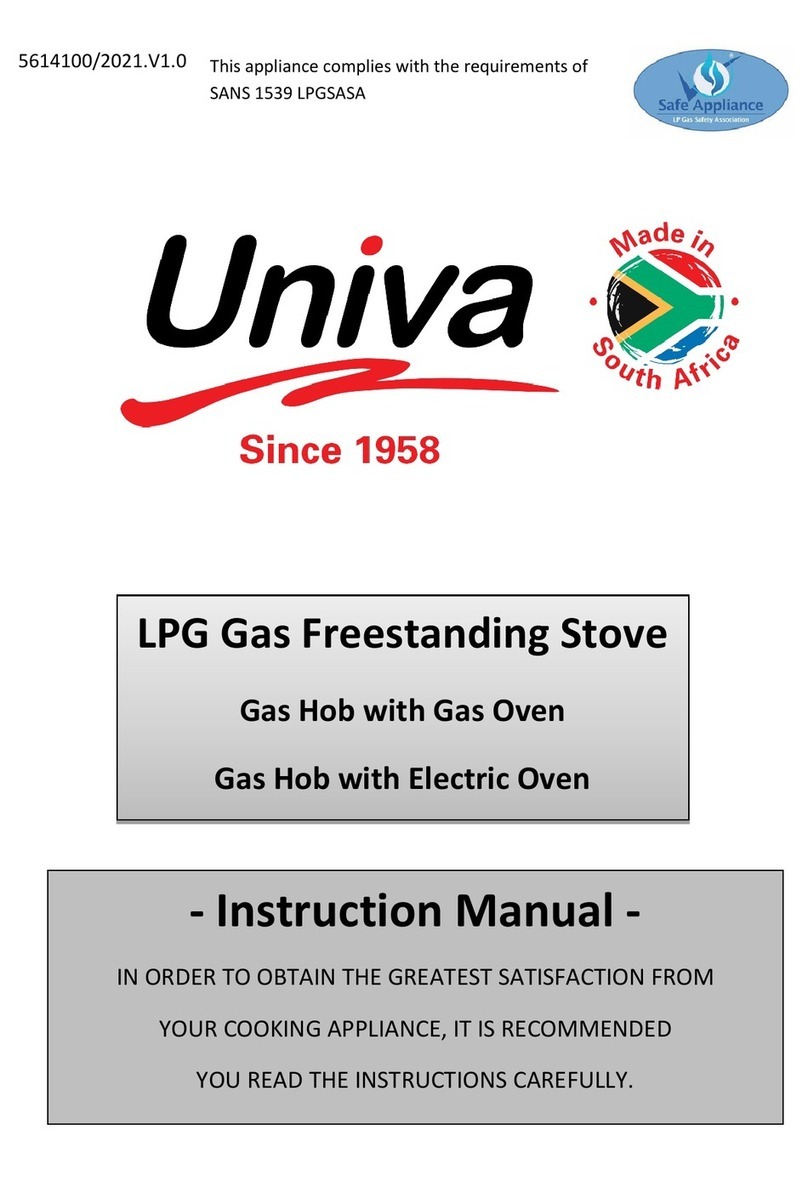TEK Biomasse DOMINA User manual

0
TEK Biomasse® 2021/NG01/K100
EN211019
Instruction Manual
Pellet Stove
DOMINA, GLAM, PRIMA AIR & STONE

1
Index
1. General Considerations ............................2
1.1. Symbology .......................................2
1.2. Use .................................................2
1.3. Packaging of documentation ...............2
2. Security warnings....................................2
2.1. Installer Technician and Maintenance
Manager...................................................2
2.2. User ................................................3
3. Legal guarantee ......................................4
4. Replacement parts...................................4
5. Fuel .......................................................5
5.1. Fuel characteristics............................5
5.2. Pellet storage ...................................6
6. Unloading and transport ...........................6
7. Installation .............................................6
7.1. Leveling the stove .............................6
7.2. Installation constraints ......................6
7.3. Stove installation location ..................6
7.4. Air intake .........................................7
7.5. Smoke evacuation duct......................8
7.5.1. Basic requirements ......................8
7.6. Electrical installation........................10
7.7. Installation test...............................10
7.8. Maintenance ...................................10
7.9. Other information............................10
7.9.1. Calculation of thermal power and
average hourly consumption ...................10
8. Use of the stove ....................................10
8.1. Useful information ...........................10
8.2. Lighting .........................................11
8.3. Stop ..............................................11
8.4. Unplug the device from the mains .....11
8.5. K100 Control Panel Functions............12
8.6. State .............................................12
8.7. Messages .......................................13
8.8. Views.............................................13
8.9. User Menu 1 ...................................14
8.10. User Menu 2 ...................................15
9. Maintenance .........................................16
9.1. Security measures...........................16
9.2. Maintenance to be carried out by the
user 16
9.2.1. Daily cleaning............................16
9.2.2. Weekly cleaning ........................16
9.2.3. Semi-annual cleaning .................18
9.3. Complete cleaning - Technician .........19
9.3.1. Chimney cleaning ......................19
9.3.2. Door check ...............................19
9.4. Exterior cleaning .............................20
9.5. End of season maintenance ..............20
9.6. Control and maintenance program.....20
10. Error codes ...........................................21
11. Electrical scheme...................................24
12. Dimensions and connections ...................25
13. Models and technical characteristics.........29

2
1. GENERAL CONSIDERATIONS
TEK Biomasse ® is a registered trademark, whose
air conditioning equipment is manufactured by
Vitor Monteiro Lda., and tested in accordance with
European reference safety standards.
1.1. Symbology
The following graphic symbols are used in this
manual:
- Tips and useful information,
- Danger, important information to avoid
accidents.
Attention: the symbols indicate important
information in order to make the manual more
lucid. However, this does not relieve the user of
the obligation to comply with requirements that
are not marked with a graphic symbol.
This manual is divided into two parts: one for the
user and one for the installer. Both parts contain
important and significant information for safety
issues, therefore, the user should read both parts
of the manual. We are not responsible for any
damage caused by failure to follow these
instructions.
1.2. Use
This equipment is a stove intended for domestic
heating and is reserved for indoor installation. It
must not be operated by anyone unfamiliar with
this manual as well as by children, the elderly and
others whose physical, mental and intellectual
capacities are impaired.
Failure to observe these rules can cause property
damage, threat to human life and health and
domestic animals.
1.3. Packaging of documentation
This manual, as well as any other applicable
documentation, must be stored diligently so that
it is available at all times. In case of moving or
selling the equipment, the documentation must
be attached and forwarded to the new
user/owner.
2. SECURITY WARNINGS
The instructions contained in this manual must be
followed, both by the Technician (Installer,
Maintenance) and by the User. Some of the
warnings, if not followed, void the warranty
contract.
2.1. Installer Technician and
Maintenance Manager
The installation of the stove is reserved
exclusively for specialized technicians.
The responsibility for installing the equipment
cannot be considered the responsibility of Vitor
Monteiro, Lda.
In case of need for works at the installation site
of the stove, these are the responsibility of the
user and whose expense falls on the same. The
works, before being carried out, must be
approved by the user.
The technical responsibility for the installation
rests with the installer, who is asked to carry out
the chimney and air intake checks and carry out
the proposed installation solutions correctly.
Installation of the equipment must comply with
all national and European regulations, standards
and laws.
The equipment must be installed on a surface
capable of supporting its weight.
Confirm that the chimney design and air intake
are in accordance with the installed equipment.

3
Do not make electrical connections with
temporary or non-insulated cables.
Check that the equipment ground connection is
effective.
Before starting the unpacking and assembling or
disassembling of the stove, the Technician must
take the safety measures prescribed by law, with
special attention to those mentioned below:
•Ensure that the equipment installation site
complies with all national and European
regulations/laws;
•Ensure the use of all personal protective
equipment;
•Make sure that the workplace is in a safe
condition to perform the installation;
•To perform the installation, the installer
must be in full psychophysical conditions;
•No work should be carried out under
adverse conditions.
During maintenance operations, the
technician must carefully observe the following
instructions:
•Maintenance should only be carried out by
qualified personnel, at least once a year;
•Check that the stove is cold before
carrying out any type of work;
•Disconnect the equipment from the
electrical current before starting
maintenance work;
•Use personal protective equipment and/or
other means of protection;
•All electrical and mechanical components
guarantee the correct functioning of the
stove, so they can only be replaced by
original components purchased from the
brand's technical assistance;
•The equipment must be taken out of
service if any safety component is
defective or out of calibration.
On water models, the installer must inform
the user of the following:
•In case of water leaks, it is necessary to
turn off the water supply and immediately
notify technical support.
•System pressure operation must be
checked periodically.
2.2. User
Before using for the first time, the user must read
this manual in its entirety and bear in mind the
following:
•Immediately disconnect the equipment
from the power supply in the event of a
breakdown or malfunction;
•The power plug must be easily accessible;
•When in normal operation, never
disconnect the appliance from the
electrical supply;
•If you are not going to use the stove for a
long period of time, disconnect the power
and remove the pellets from the hopper;
•After a more or less prolonged downtime,
the stove should be regularly serviced;
•The stove must not be switched on without
having carried out the daily maintenance
and/or inspection as referred to in point
9.2.1 Daily ;
•This stove does not work with wood, use
only 100% wood pellets as fuel according
to the manufacturer's recommendations.
See point 5.1 Fuel characteristics;
•This equipment is not an incinerator
do not use foreign substances as fuel;
•It is forbidden to operate the equipment
with the door open or with broken glass,
or even to open the door with the
equipment in operation;
•The equipment lights up automatically, so
you should not use any product to light the
stove, especially flammable liquids;

4
•When in operation, the stove has very hot
surfaces, so you should not approach or
touch them, with special emphasis on the
glass and door, chimney, among other
elements;
•The glove supplied with the appliance
must be used to handle the appliance's
components.
•It is forbidden to place clothes to dry or
other objects on the equipment or in its
proximity that impede the free circulation
of air;
•Clean the equipment only when it is
completely cold and turned off;
•The ash compartment must not be opened
while the stove is operating. Wait for it to
stop and cool down completely to clean
the ash.
Children: - Do not let children play near
the stove or touch it.
•The equipment extinguishes by itself, so
do not use water or to put out the fire in
the brazier;
•Periodically clean the chimney according
to the instructions in point 9.3.1- Chimney
cleaning.
3. LEGAL GUARANTEE
The manufacturer guarantees the product, with
the exception of elements subject to normal use,
listed below, in compliance with Directive
CEE199/44/EC from the date of purchase attested
by:
•Invoice with date of purchase;
•Installation compliance certificate issued
by the installer.
Exclusions:
The warranty does not cover damage or
malfunctions arising from the following causes:
•Damage caused during transport or
handling;
•Failure of components resulting from
improper use or negligence, lack of
maintenance, installation in violation of
current regulations and laws.
•Use of poor quality pellets or any other
similar product in disregard of the
provisions of Point 5;
•Malfunctions resulting from poorly
executed repair attempts;
•Forced use of equipment after failure
alarm;
•Chimney malfunction;
•Damage caused by tampering with the
equipment, atmospheric agents, natural
disasters, vandalism, electric shocks,
fires, failures resulting from the electrical
or hydraulic network.
The following items subject to normal wear and
tear are not covered by the warranty:
•Vermiculite;
•Door glass;
•Fiber gaskets;
•Painting;
•The brazier (burner) in cast iron;
•The ignition resistance.
4. REPLACEMENT PARTS
In maintenance operations, only original parts
may be used . For this purpose, consult the
technical assistance service.
Do not wait until the complete failure of the
components, therefore, it is recommended that
During the first lighting of your equipment,
it is possible that some odors may be
released resulting from the natural drying of
paints and putties. Avoid prolonged
exposure to these odors. It is advised:
•Air the space;
•Do not touch surfaces when they are
hot to avoid damaging the coating.

5
they be replaced when necessary in the periodic
maintenance actions.
The manufacturer will guarantee replacement
parts for the legally prescribed period.
5. FUEL
100% pressed pine wood pellets certified
according to the EN PLUS A1 standard are the
only fuel allowed for use in this boiler .
The pellets used must be certified and in
accordance with EN Plus 14961 or 17225-2.
5.1. Fuel characteristics
Pellets are produced by pressing wood chips and
sawdust. They are obtained without the addition
of any foreign substance, such as adhesives,
lacquers or synthetic substances.
Pressing through a matrix of holes and the heat
produced by friction and pressure, activates
natural wood binders that in this way ensure the
shape of the pellets even without the addition of
binders.
The production and consumption of pellets is
based on the rational use of renewable energy
with zero impact on the CO 2 cycle , which respects
environmental protection standards.
This is the only fuel indicated for this equipment.
Yield and power vary depending on the quality of
pellets used.
For correct operation you must use pellets
according to the characteristics below.
Technical Fuel Information (Pellets)
Diameter
6mm
Length
10 to30 mm
Density in the bag
min. 650 kg/m 3
Humidity
Max. 10%
Max. from the ashes
Max. 1.5%
Max. from the dust
Max. 2.3%
Calorific value of various fuels:
Wood pellets
4.9 kWh /kg
Wood chip
± 850kW.h/m 3
Soft woods
±1500 kW.h /m 3
Hard woods
±2000 kW.h /m 3
Coal
7 kW.h /kg
Naphtha
7.5 - 8 kW.h /kg
Natural gas
9.5 - 10.2 kW.h /m 3
Liquid gas
12.8 kWh /kg
The stove is equipped with a hopper (deposit) for
pellets with a capacity for 1 bag of 15 kg.
The supply of pellets must only be carried out
through the door that gives access to the cargo
compartment located at the top. This should only
be opened to load the pellets and only when it is
not in operation, it is not advisable to supply
pellets with the stove in operation.

6
Figure 1- Prima Air charging cover
5.2. Pellet storage
The functioning of the stove depends largely on
the quality and conservation conditions of the
pellets, for this reason they must be stored in a
dry place where they do not reach too low
temperatures.
Poor packaging of the pellets can lead to the
breakdown of particles and create sawdust.
Sawdust is responsible for the malfunction of the
power system and can block it.
We recommend storing a few bags of pellets
in a warm and dry place, because cold pellets
(5º.C) and/or damp reduce the calorific value of
the fuel and cause more dirt, requiring more
rigorous maintenance and cleaning.
6. UNLOADING AND TRANSPORT
The stove must be transported vertically without
rocking during the entire transport process.
The stove's brazier as well as other components
can come loose causing damage to the product.
The stove's packaging must not be impacted or
hit by other objects or equipment, under penalty
of causing damage that will compromise the
stove's future operation.
Make sure that the means of transport used has
a capacity greater than the weight of the stove.
7. INSTALLATION
To obtain the best performance from the stove
and uniform heating of the room, you must
comply with some essential rules.
Improper installation will compromise the safety
and proper functioning of the stove.
When installing the equipment, all national and
local regulations, as well as European standards,
must be observed.
7.1. Leveling the stove
The stove must be leveled using a bubble water
level and using the rubber adjustment feet.
7.2. Installation constraints
It must be safeguarded that no mechanical
exhaust fans or collective ventilation ducts are
installed at the installation site.
In any case, it must be safeguarded that the
installation site is not in a depression, preventing
the simultaneous operation of the systems
mentioned above, since this will compromise the
normal functioning of the stove and possible
release of dangerous fumes. Check point 13 -
Models and technical characteristicsfor more
information.
7.3. Stove installation location
The following figure indicates the minimum
distances (in centimeters) from combustible
surfaces that must be observed when installing
the stove. In the case of non-flammable
walls/objects these distances can be reduced by
half.

7
Figure 2- Minimum dimensions to respect in relation to
adjacent surfaces
The floor protection to support the stove must
guarantee fire resistance in accordance with
European standards. Never place the stove
directly on wood, carpet or other combustible
materials.
During installation, structures, coverings, beams,
etc., must be protected from combustible or
flammable material and which are exposed to
excessive heat from both the stove and the
chimney, particularly when crossing partitions
and false ceilings. In these cases, appropriate
thermal insulation should be used, namely
vermiculite.
Check point 13 - Models and technical
characteristicsfor more information.
Figure 3- Minimum dimensions to respect the envelope and
minimum height of the chimney
The manufacturer will not be responsible for
changes in the properties of the materials
surrounding the stove and chimney.
7.4. Air intake
The heat generated by the stove results from the
heat produced by the chemical reaction of
combustion of the pellets in the combustion
chamber.
For this combustion to occur under the best
conditions, it is necessary to safeguard the
correct amount of oxidizing agent (oxygen
present in the air).
During operation, the stove absorbs an amount of
air from the place where it is located, which
enters the combustion chamber through an air
inlet located at the back of the stove, which can
be channeled to the outside.
You must not use bends or tubes with a section
smaller than 60mm, nor a maximum length
greater than 800mm.
You must also safeguard that this admission will
never be obstructed from the outside and that it
is at least 20 cm from the ground.
Outside, you should put protection against rain
and wind.
Safeguard the requirements and relative to
ventilation and air supply referred to in point 7.2-
Installation constraints.

8
In the figure below you will find several examples
that will help you to verify the stability and
correction of the flame.
Correct combustion
Bright flame with light
yellow color and minimum
amount of pellets in the
brazier
Incorrect combustion
Flame too bright too
much oxidizer.
Too many glowing pellets
come out of the brazier.
Correct the amount of air
(from 0 to +5) correct the
feeder if necessary (from
0 to -5).
If not, contact technical
support.
Incorrect combustion
Flame too dark yellow,
wobbling, with too many
unburned pellets in the
brazier.
Check that the door or
ash bin is closed.
Otherwise, correct the
amount of air (from 0 to
+5) correct the feeder if
necessary (from 0 to -5).
If not, contact technical
support.
7.5. Smoke evacuation duct
The smoke discharge from the stove is with
positive pressure in relation to the surrounding
environment, so it is essential to guarantee the
tightness of the different joints of the chimney.
The smoke evacuation duct must be independent
from other equipment.
To guarantee the correct extraction of the smoke,
it is mandatory that the first section of the
chimney be vertical with a height of not less than
1.5 meters.
The horizontal sections must not be longer than
1.5 meters with a slope of at least 5%.
The chimney outlet must comply with EN 1856-2
for built-in masonry chimneys and EN 1856-1 for
insulated outdoor chimneys. It must be in 0.5mm
thick 316 stainless steel with dimensions
respecting what is indicated in the equipment
characteristics, regarding the smoke outlet.
The smoke duct must have a diameter of 80 mm,
with male/female joints fitted with a high-
temperature silicone gasket (>200ºC) with
inverted installation (male downwards) to
prevent condensation from flowing out of the
chimney.
For chimneys over 5 meters high, their section
must change to a diameter of 120 mm after 5
meters. The dimensioning of the smoke duct must
be done considering 0 Pa .
The piping used outdoors must be in double-
walled stainless steel, in order to avoid
condensation and corrosion of the same, resulting
from the thermal shock.
It is forbidden to install dampers, butterflies or
valves that strangle the chimney's draft capacity.
The fume exhaust capacity depends on several
factors, including the height of the chimney.
Depending on these factors, it may be necessary
to make adjustments to the stove's operating
parameters. Excess draft when it is not possible
to correct it by changing parameters such as air
intake and pellet loading, it will imply the
installation of an air intake valve to the chimney.
If necessary, contact the technical assistance
service.
7.5.1. Basic requirements

9
Below are some proposals for the execution of a
chimney, which should be understood as
schemes, not replacing a specialty project.
Figure 4- Example of vertical installation
Figure 5- Example of installation with wall outlet
Figure 6- Example of installation from the outside

10
7.6. Electrical installation
Installation must be carried out by qualified
personnel according to EN 10683. Ensure that the
electrical installation is earthed.
With the switch off, connect the cable to the
wall socket and plug.
Figure 7
Turn on the switch to electrically power the stove.
Figure 8
For more information, see point 10- Error codes
Origin
Cause
Action
Er01
Auger or boiler safety
thermostat
It occurs if the hopper (85ºc)
or boiler (95ºc) limit
temperature is exceeded.
The water is not circulating.
Circulator pump blocked with
dirt, installation with air in the
circuit, or closed radiator
valves.
Check the installation.
Wait for the boiler or
hopper to cool down and
for the message Stop or
OFF to appear on the
display.
Er02
Combustion chamber safety
pressure switch.
Occurs if the combustion fan
cannot make a depression in
the combustion chamber
greater than 20Pa.
Chimney clog.
Door or ash drawer not
properly closed.
Loose door cord.
Silicone tube or clogged
pressure socket.
Check chimney
cleanliness
Check the door and
seals.
Check the pressure
gauge of the pressure
switch.
Return of wind through the
chimney
Er03
Smoke temperature sensor
Extinguishing combustion due
to low smoke temperature,
lack of fuel
Occurs if the smoke
temperature drops below the
minimum value set for
extinguishing.
Lack of fuel
Low calorific fuel
Too-down correction of pellet
recipe
Er04
Boiler temperature sensor
Exceeded boiler water
temperature (90ºc).
Circulator pump blocked, air in
circuit or any valve closed or
blocked.
Er05
Smoke temperature sensor
Extinguishing combustion due
to excessive smoke
temperature.
Lack of cleaning of the smoke
circuit.
Lack of dissipation, obstructed
or blocked ambient fan.
Correction too upwards of the
pellet recipe
Er07
Combustion fan encoder.
Combustion fan encoder
error:
Occurs if the rotation signal is
not received by the controller.
Check the plug and connecting
cable on the fan and controller
Er08
Combustion fan encoder.
Occurs if the controller is
unable to obtain rotational
speeds according to the value
defined by it.
Check the plug and connecting
cable on the fan and controller
Possible fan or encoder
malfunction
Er09
Water pressure sensor
Occurs if the boiler water
pressure drops below 0.4bar
Water pressure dropped below
0.4bar.
Er10
Water pressure sensor
Occurs if the water pressure
exceeds the value of 2.4 bar
Check the auto-fill valve, it
may be blocked.
The installation does not have
an expansion vessel capable
of accumulating the expansion
of water by heating it.
When the water reaches 75ºc,
the pressure must not rise by
more than 0.5 bar.

11
Er11
Internal clock error
Incorrect day and time due to
prolonged absence of power
supply
The boiler has been
disconnected from power for a
long time and the internal
battery has discharged, losing
the programming.
Call a technician.
Er12
Smoke temperature sensor
Misfire
The smoke temperature did
not reach the ignition setpoint
(+/-50ºc) and after this value
it did not rise by another 5ºc.
Lack of pellets in the hopper
Blocked auger
Pellets with high moisture
content
Brazier obstructed
End of life igniter
Check the level of pellets
in the hopper, clean the
burner and check the
resistance against the
burner
Er15
Lack of supply voltage 230V,
A power failure has occurred
Lack of electricity
Check outlet, electrical
panel.
Er16
RS485 communication error
Occurs when communication
between controller and panel
fails
Lack of communication
between panel and controller
Check plug or cable.
Reset and reconnect.
Er17
Air flow meter error
Occurs if the chimney is
clogged
Check sensor connections
Check chimney, possible
obstruction.
Open ash door or drawer
Er18
Pellet level sensor
It only occurs if the equipment
is equipped with a pellet level
sensor
Pellet level does not cover
sensor
Hopper without pellets
Refill hopper
Er23
Boiler sensor, DHW open
circuit.
The boiler is programmed to
read one or more of the
following sensors and has not
detected them:
Boiler temperature
DHW temperature
Check sensor connection
In case the boiler does
not have DHW, it must
be deactivated by
changing the following
parameters P26=5 and
P83=0
Er39
Air flow/mass sensor
Damaged sensor
Change sensor
Call a technician.
Er41
Air flow/mass sensor
During the Check Phase Up
the boiler makes the exhaust
capacity diagnosis.
Minimum reference value not
reached.
Possible obstruction of the
chimney or air intake.
Open ash door or drawer
Clean the chimney.
Check door seal and ash
drawer
Er42
Air flow/mass sensor
Maximum air flow reached,
excessive chimney draft.
The use of swivels or
fans in the chimney is
not allowed.
During the Check Phase Up
the boiler makes the exhaust
capacity diagnosis.
The maximum reference value
has been exceeded
Er44
Open door error
Er56
Hydraulic scheme different
from boiler configuration
SerU
Notifies that the planned
hours of operation (parameter
T66) are reached. Periodic
review is required.

12
Electrical in this manual.
7.7. Installation test
8.2 - Lightingand 8.3- Stopmust be taken into
account.
7.8. Maintenance
When installing the equipment, the space
required for maintenance and cleaning of the
equipment and respective connection and smoke
evacuation ducts, as well as the respective
hydraulic networks (water models) must be taken
into account.
For more detailed information, see point 9-
Maintenance.
7.9. Other information
7.9.1. Calculation of thermal power
and average hourly
consumption
The calculation of the thermal power required for
heating a given space can be performed using a
very simple method, since, on average, the
heating power required for a properly insulated
room is approximately 40 W/m 3.
If we want to heat a space with 100m 3 then we
have:
100m 3 x40W/m 3 = 4000W, that is, 4 kW.
For this main heating requirement, a 6.5 kW
appliance will therefore suffice.
8. USE OF THE STOVE
Watch videos on using and maintaining your
equipment at www.tekbiomasse.com
8.1. Useful information
Fuel used: see point 5- Fuel.
In order to avoid the risk of fire, you must comply
with the instructions contained in point 2.2- User-
Security warnings, with special emphasis on the
following aspects:
•It is forbidden to place clothes to dry
or other objects on the equipment or in its
proximity that block the free circulation of
air;
•Clean the equipment only when it is
completely cold and turned off ;
•The ash compartment must not be
opened while the stove is operating. Wait
for it to stop and cool down completely to
clean the ash.
Simultaneous use with other ventilation systems:
see point 7.2- Installation constraints.
Safeguard the safety distance from combustible
materials: see point 7.3- Stove installation
location.
Air supply and smoke evacuation: see points 7.4-
Air intakeand 7.5- Smoke evacuation duct.
If a fire occurs in the equipment or chimney, you
must:
•Immediately turn off the equipment;
•Do not open any equipment door;
•Do not use water to put out the fire;
•Putting out the fire using a CO2
extinguisher
•Request the intervention of the fire
department.
See the terms of legal warranty and replacement
parts in the points: 3- Legal guaranteeand Erro!
A origem da referência não foi encontrada.-
Erro! A origem da referência não foi
encontrada..
8.2. Lighting
The stove is switched on by pressing the ON/OFF
key for 3s.
The word “Activation” will appear on the display
until ignition is complete. This process will take
an average of 5 to 12 min. Once completed, the
ignition will move to a flame stabilization phase
and, finally, it will enter the previously selected
power level or what was in use when the stove
was last turned off.
User can select 5 power levels.

13
8.3. Stop
Stopping is carried out by pressing the ON/OFF
key for 3s. The word “Deactivation” will appear on
the display. The feeding of pellets will be stopped,
and the room and smoke extraction fans will be
activated to guarantee the complete burning of all
the material until the temperature of the stove is
reduced to 40ºC.
8.4. Unplug the device from the
mains
Attention! Ensure that the device is not
disconnected from the power supply when it is in
operation. This process requires that the device is
not performing any operations and that the
display shows “OFF”.

14
8.5. K100 Control Panel Functions
The Main Panel shows:
Time and date, chrono activation,
combustion power, heating,
power, operating mode, ambient
temperature and required main
temperature
keys
Occupation
P1
Exit Menu/Submenu
P2
Ignition/Extinguishing (press 3sec), Error Reset (press 3sec), Chrono On/Off
P3
Enter User Menu 1 / submenu, Enter User Menu 2 (press 3 sec.), save data
P4
Enter views menu, zoom in
P5
Enter views menu, zoom out
LED
Occupation
LED
Occupation
External Chrono
Local thermostat temperature reached
Missing pellets
Remote thermostat temperature
reached
air flow direction
8.6. State
State
Code
State
Code
OFF
-
Operation
-
Verification
Check
Modulation
mod
Ignition-Preheating Phase
on 1
Standby
STBY
Ignition-Pre-Charge Phase
on 2
Safety
SAF
Ignition-Fixed Phase
on 3
Extinction
OFF
Ignition-Variable Phase
on 4
Block
Alt
Stabilization
on 5
Recover the ignition
rec

15
8.7. Messages
Description of messages
Code
Viewing the status of the temperature probes. The message displayed in the
Check-Up indicates that the temperature reading on one or more probes is equal
to the minimum (0 °C) or maximum value (depends on the probe considered).
Check that the probes are not open (0 °C) or that they are short-circuited
(maximum value of the temperature scale).
probe
Open door. You must close the door!
door
Delay in stopping the equipment. The equipment was turned off when it was on.
Wait for this operation to complete.
OFF DEL
This message notifies you that the planned hours of operation (parameter T67)
are reached. Proceed to cleaning. To clear the warning see Reset Clear ( rclr )
CLr
Periodic cleaning running. Information message that the equipment is
performing periodic cleaning.
PCLr
Supply pellets
rFiL
Open hopper thermostat.
FLAM
Automatic periodic cleaning running
PCLr
8.8. Views.
Display
Un
Description
K100
T. Exhaust
[°C]
Smoke temperature
T. Room
[°C]
Local temperature; visible if A19=1
T. Remote room
[°C]
Remote ambient temperature; visible if remote probe is
configured and P69>0
Air flow *
-
Primary airflow velocity; visible Input was set to " Air Flow
Sensor "
Fan*
[rpm]
Combustion fan speed; visible if P25 ≠ 0
Auger *
[s]
Power auger connected; visible if P81 ≠ 0
Receive
[ nr ]
Selected combustion recipe; visible if P04 > 1
Service
[H]
Service ' message ; visible if T66 > 0.
Cleaning
[H]
Timer for cleaning the greenhouse; visible if T66 > 0.
Working hours *
[ nr ]
Work hours.
Ignitions *
[ nr ]
Number of ignitions/ignitions.
Product _ Code 559-
xyzt *
Firmware code and revision: fysr02000001.xy

16
8.9. User Menu 1
Access to the menu is done by pressing P3
Power
Combustion
By entering this menu, you can change the combustion power of the
system. You can configure it in automatic or manual mode: in the first
case, the system chooses the combustion power; in the second case, the
user selects the combustion power of their choice. On the left side
From the screen, the combustion mode is displayed (a = automatic
combustion, m = manual combustion) and the operating power of the
system.
Heating
By entering this menu, you can change the heating power. You can
configure it in automatic or manual mode: in the first case, the system
chooses the combustion power; in the second case, the user selects the
combustion power of their choice. On the right side of the screen the
heating mode is displayed (A = automatic, M = manual) and the
corresponding power.
By setting parameter A04 = 1, the menu is not displayed.
Thermostats
Living room
Menu to change the main thermostat value. Only displayed if a19 = 1.
Remote
Menu that allows changing the value of the remote thermostat; is displayed
only
If an input is set to remote room probe and p69 > 0.
Chrono
Allows you to program and enable the ignition/extinguishing system. It's composed by
2 submenu.
Modality
Allows you to select the mode, or disable all programs.
- Enter edit mode with P3 key
- Select the mode of your choice (Daily, Weekly or
Weekend)
- Activate / deactivate chrono mode with the P2 key
- Save settings with P3 key
Program
The system includes three types of programs: Daily,
Weekly, Weekend. After selecting the program of your
choice:
- Select the programming time with the P5 or P4 keys
- Enter edit mode (selected time flashes) with
P3 key
- Change the time with the P5 or P4 keys
- Save the program with the P3 key
- Enable (a “V” is displayed) or disable the time interval
(a “ V” is not displayed) by pressing the P2 key
Daily
Select the day of the week you want to program and
activate the ignition and extinguishing times.
Schedule until midnight

17
Set the ON time of the first day to the desired value:
Ex. 20.30
Set the OFF time of the first day to 23:59
Set the next day's ON time at 00:00
Set the next day's OFF time to the desired value:
Ex. 6:30
The system will turn on on Tuesday at 20:30 and turn off
On Wednesday at 6:30 am
Weekly
The programs are the same for every day of the week.
Weekend
Select between Monday to Friday and Saturday to
Sunday times and set the ignition and extinguishing time.
Refill
This menu allows you to activate the fuel consumption count and displays the
estimated pellet remaining in the tank. 4 levels of charge are available: 100% (tank
full), 75%, 50%, 25%, 0 (function disabled). To ensure proper operation, the
manufacturer must configure parameters P111 and P112.
Load
The procedure switches on the manual loading of the pellet and stops automatically
after 300 seconds. The system must be in the off state for the function to run.
8.10. User Menu 2
Access to the menu is done by pressing P3 for 3s
Settings
Date and time
Allows you to change the current date, day, month, year and time.
Language
Allows you to change the language of the panel.
Remote control
Allows enabling/disabling remote control (optional extra)
Endless calibration
Allows you to correct the pellet feed according to the quality of the pellets
used.
Extractor calibration
Allows you to correct the extraction rotation to compensate for a greater or
lesser chimney draft.
Automatic power
Allows you to set the combustion level to automatic
Keyboard Menu
Shine
Allows you to adjust the brightness of the panel.
Contrast
Allows you to adjust the panel contrast.
My Light
Allows you to adjust the minimum brightness of the panel.
Key tone
Allows you to adjust the sound of the panel keys.
System Menu
Menu for access reserved for technical personnel. It is password protected-

18
9. MAINTENANCE
9.1. Security measures
Before starting maintenance work, make sure
that the stove is disconnected from the electricity
supply, that the stove is cold and the ashes are
out.
Turn off the main power switch located on the
rear panel, right side, and the corresponding
cable.
Use suitable cleaning equipment.
It is recommended to use a vacuum cleaner
suitable for ash.
9.2. Maintenance to be carried out
by the user
9.2.1. Daily cleaning
Due to the accumulation of ash in the brazier in
your equipment, which may cause failure to light
or lack of performance, it is necessary to clean it
daily.
Carefully clean the brazier, ensuring that all holes
are clear.
It is natural for “stone” to form at the base of the
brazier, this phenomenon largely depends on the
quality of the pellets used.
Figure 9- Brazier
Put the brazier back in place ensuring the perfect
alignment of the resistance hole with the
respective resistance. Incorrect alignment can
cause ignition failure.
9.2.2. Weekly cleaning
Glass cleaning
Wait for the glass to be completely cold,
otherwise it will break. The weekly cleaning of the
glass should be done with a damp cloth or paper
mixed with a little ash rubbing until it is clean.
You can use special products or foams for
neoceramic glass by placing it directly on a cloth
or paper, but never projecting it directly onto the
glass.
IMPORTANT, do not let the product run into the
metal parts as it will cause corrosion and quickly
deteriorate your stove.
Ash cleaning
The cleaning of the compartment that houses the
ash box must be carried out from week to week
or when necessary.
To clean it, it is necessary to remove the ash box
using the process explained below.
The compartment must be cleaned using an ash
vacuum.
Clean the exchanger by pulling and pushing the
central louver on the grate.

19
Models Domina/Glam/Prima Air /Stone
Clean the exchanger by pulling and pushing the
shaft located between the central fins of the grid
as shown in the picture below.
Open the combustion chamber door, remove the
brazier and vacuum the ash using an ash vacuum.
To access the ash compartment, lightly press the
lower cover and move it away as shown in the
image below.
Open the ash drawer by turning the handle from
top to bottom.
Once the handle is placed horizontally, pull out
the drawer.
Carry out the same operation for the lower lid.
This manual suits for next models
3
Table of contents
Other TEK Biomasse Stove manuals
Popular Stove manuals by other brands

Moretti Design
Moretti Design ELEGANCE GLASS A 9 DEDICATED MANUAL
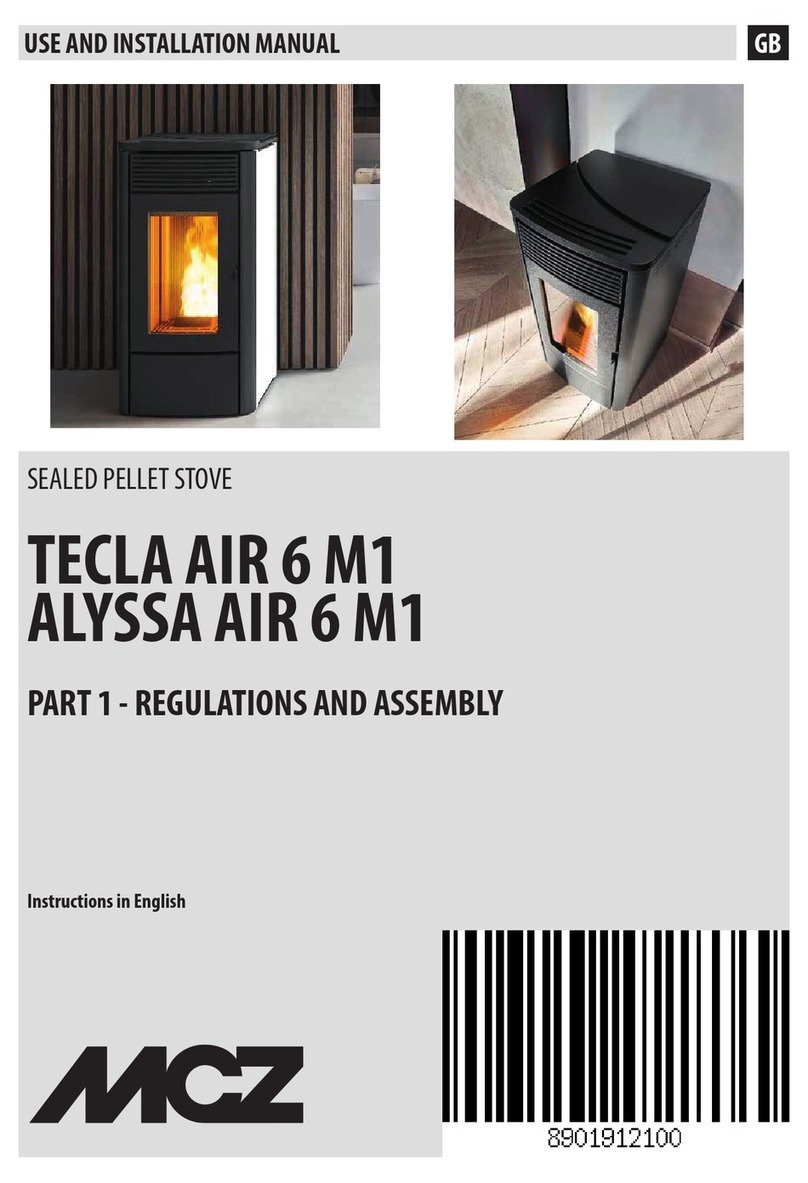
MCZ
MCZ ALYSSA AIR 6 M1 Use and installation manual
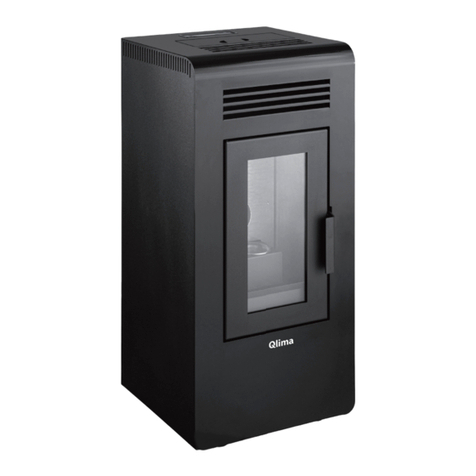
Qlima
Qlima ECO 1700 Directions for use

Palazzetti
Palazzetti CLEMY Instructions for use and maintenance

EdilKamin
EdilKamin Italiana Camini DAFNE Installation, use and maintenance

Hunterstoves Group
Hunterstoves Group Aspect 14 Eco Boiler installation instructions

